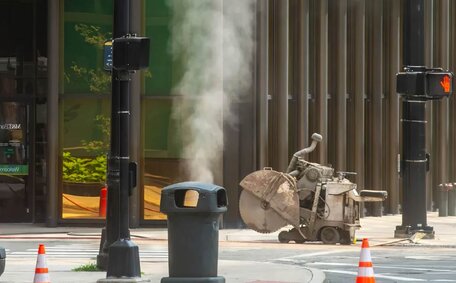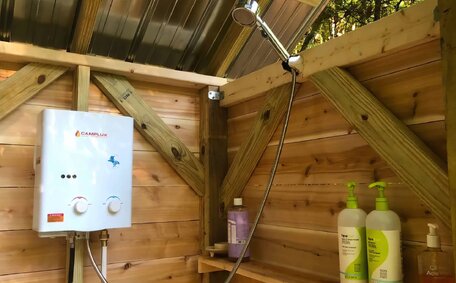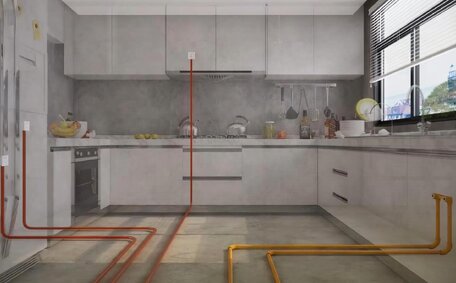
How To Move A Gas Meter
Need your gas meter relocated? You can’t move it yourself - contact your supplier to arrange for a gas engineer to reposition it safely. Charges may apply depending on circumstances.
Read MoreTree roots invading drain pipes can obstruct pathways, causing serious plumbing issues. Roots expand towards water sources and may penetrate your sewer system, leading to obstructions.
Blocked drains often signal tree root intrusion, reducing pipe functionality. Gurgling sounds and slow drainage are warning signs of impending blockages due to roots. Left unchecked, roots can fully clog pipes, resulting in sewage backups and costly repairs.
Pipe relining effectively halts root blockages and safeguards your drains from future damage. Relining, a less invasive alternative to pipe replacement, lines the inside of pipes creating a root-resistant barrier. Preventative measures like relining can mitigate future costly root intrusion repairs.
Tree roots are naturally drawn to the lure of underground pipes, as they consistently offer the vital elements for growth—nutrients and moisture. These organic deposits in your sewer system become a target for tree roots as they make their way into an environment rich with essential nutrients. Sewer pipes also contain a steady supply of water that roots readily absorb.
The negligible fissures and junctions in ageing sewer pipes provide convenient entry points for roots to breach into pipe interiors and establish themselves. Tree roots invade quickly, the tree’s root system rapidly expanding in the nutrient-rich sewer environment. Mature roots can fill the pipe’s diameter, causing severe obstructions.
Tree roots from local foliage can pose a significant threat to the structural integrity of the sewer line, potentially leading to comprehensive sewer issues and serious plumbing challenges. Common issues include reduced water flow, gurgling sounds, unpleasant odours, and wastewater backing up into homes, requiring professional root removal. Tree root intrusion requires prompt action to clear tree roots and blockages, and to prevent catastrophic pipe bursts.
Proactive strategies including the installation of root barrier methods and pipe lining can help deter roots before they grow into your plumbing network. For existing root infestations, hydro jetting and thorough drain cleaning can efficiently clear obstructions and restore flow.
Several clear signs indicate tree root invasion in your plumbing system. Slow drainage from sinks, showers and toilets is most likely one of the earliest symptoms as roots growing within your pipes take hold and obstruct water flow. Homeowners may also hear gurgling noises coming from affected drains as water attempts to navigate roots in the sewer line causing blockages.
Sewer gas odours or methane smells around drains can signal roots rotting inside pipes. Backed up sewage and overflows point to severe tree rootrelated plumbing blockages. Reduced water pressure, frequent plumbing clogs and the need for drain cleaning are other common signs of tree root intrusion.
Catching root issues early in your sewer line is key, so contacting a professional plumber at the first signs can help avoid extensive repairs. Sewer line inspections and drain camera scoping can also confirm if tree roots are the cause of any plumbing problems.
Taking proactive steps to fend off any tree root damage your sewer lines could sustain is here some essential ways to circumvent costly plumbing issues. Here are some preventative measures for property owners:
Relining sewer pipes stands as the most effective prevention tactic to cease root growth permanently and sidestep expensive plumbing damage repairs. Compared to digging and replacing lines, relining is far less disruptive to properties.
Addressing the initial indications of root issues, like sluggish drains or rumbling sounds, enhances your plumbing systems’ resilience, effectively removing tree root predicaments before they firmly establish. A professional plumbing inspection can determine if roots are an issue and recommend the optimal solutions.
When selecting and positioning trees, it’s crucial to ensure their roots won’t invade areas near your pipes to avoid potential issues. Here’s a guide to responsible tree planting:
Investing time in selecting suitable trees and strategically placing them at a distance from critical sewer infrastructures can mitigate the risk tree root interference and avert destructive blockages. Consulting with an arborist can provide guidance on choosing tree species less prone to plumbing damage. Proactive planning creates a landscape that’s both beautiful and sewer-safe.
Installing Physical or chemical root barriers are effective in preventing destructive root growth into sewer pipes. Some options include:
Physical root barriers provide a long-lasting solution by fully blocking root access to pipes. Chemical treatments must be reapplied annually as roots try to grow past the treated areas. Professional installation is recommended for effective management of roots in your sewer lines.
Root barriers can be established as a preventative step when planting new trees to guard against roots sewer lines encroachment. For existing root intrusions, combining mechanical removal with barriers gives the best protection against future damage. Compared to pipe replacement, barriers present an affordable and non-destructive remedy.
Early intervention is key to stop small roots your drain before they expand and cause major blockages. If you suspect root intrusions, contact a plumber to inspect pipes and recommend the best barriers.
Physical root barriers provide a long-lasting solution by fully blocking root access to pipes.
This trenchless method coats the inside of damaged pipes with epoxy resin, effectively creating a new pipe within the old. Relining seals cracks and gaps where roots enter and leaves a smooth, impervious barrier that stops any further root growth.
Compared to full pipe replacement, relining is far less disruptive to your plumbing system, can be completed in a day, and costs a fraction of the price. It also has a long lifespan of 50+ years. For both existing root damage and prevention, pipe relining offers comprehensive protection.
Pipe bursting is another modern, trenchless technology for replacing badly damaged pipes without digging. It involves splitting the old pipe then using powerful machinery to burst and expand a new pipe in its place. The fragments of the old pipe are displaced into the surrounding soil.
This method is more intrusive compared to relining but necessary for comprehensive pipe repair in cases of severe root infestation. The new pipe is also thicker-walled plastic, extremely resistant to future root damage. Pipe bursting provides a full pipe replacement solution when relining is not feasible.
Both relining and bursting permit the renewal of damaged pipes to seamlessly integrate into your existing property without major digging or destruction. For the latest pipe renewal solutions, homeowners should contact a professional plumber to inspect damage and recommend the best remedy.
Modern and effective solutions repair sewer line damage from tree roots, preventing harm to your plumbing system.
Pipe relining is a trenchless technique for repairing root damage and preventing future intrusions. This method coats pipe interiors with epoxy resin, forming a protective barrier. This seals cracks and gaps where tree roots can enter from.
Compared to traditional pipe replacement, relining is far less invasive and disruptive to landscapes and property. It also takes lecks any further root growth.
Pipe relining can be used proactively on your drainage system, specifically ageing sewer lines vulnerable to root damage. It is also the go-to solution for resolving existing root infestations without major digging required. The durable epoxy coating offers the best way to extend the life of your pipes, enduring well beyond 50 years.
Pipe relining is the cost-effective and efficient modern technique to stop root intrusions without harming gardens or landscapes.
There are several situations when it’s best to call in a professional plumber to deal with tree root issues in your pipes:
Plumbers have the expertise, tools and technology to fully assess root issues and implement the best solutions. They can provide sewer camera inspections to identify problem areas and pinpoint the source of any blockages or leaks.
For severe root infestations and significant drainage issues, such as blocked drains or pipe damage, contact a professional plumber. Attempting to auger or use drain cleaners in these instances may only cause further issues.
The experienced team at Menai Plumbing have extensive knowledge dealing with root intrusions and providing modern solutions like trenchless pipe relining. We use state-of-the-art CCTV drain cameras to inspect pipes and can precisely treat affected areas.
There are several situations when it\\'s best to call in a professional plumber to deal with tree root issues:
Regular maintenance and inspections are key to prevent tree roots from intruding into sewer lines. Homeowners can help prevent major blockages by watching for signs of roots and taking proactive steps:
Catching problems in the early stages is what residents need know to prevent roots from taking hold and causing catastrophic pipe failures or sewage backups. DIY inspections and maintenance keeps pipes free of blockages between professional drain cleanings.
For the best preventative protection against tree roots near your property, partner with qualified plumbers to regularly inspect lines and take action at the first evidence of root growth. Early intervention can stop small intrusions from becoming hugely expensive repairs.
In summary, tree root intrusion into sewer lines is a common issue that can lead to serious plumbing problems if left unchecked. Proactive pipe maintenance and protection are vital to avoid blockages, backups, and damage.
Careful tree placement to avert close proximity to sewer lines, utilising root barriers, and adopting contemporary trenchless repair techniques like pipe relining offer defence against the potential damage caused by encroaching roots. Hydrojetting, professional drain cleaning, and regular inspections enable early detection and removing tree roots while they’re still manageable.
At the first sign of potential roots in your sewer line, contact a qualified plumber like Menai Plumbing. Our team can thoroughly inspect lines, pinpoint blockages and implement optimal remedies to stop roots and prevent future damage.
Don’t wait until you have a full sewer back-up or pipe burst. Take steps now to protect your plumbing from tree roots. To arrange an inspection or discuss root elimination and relining solutions, get touch with Menai Plumbing today at 1300 349 338 or email us at [email protected].
Need your gas meter relocated? You can’t move it yourself - contact your supplier to arrange for a gas engineer to reposition it safely. Charges may apply depending on circumstances.
Read MoreInvesting in a solar hot water system can save up to 75% on water heating costs. With great returns and added home value, solar hot water can be a smart choice over electric or gas heaters. Contact us to see if it’s the right investment for your home.
Read MoreWhile natural gas and propane can both power appliances in your home, they have notable differences when it comes to BTU output, infrastructure, safety, cost and more. Understanding these key contrasts will help you determine which is better for your specific needs.
Read MoreMenai, 2234 NSW
We will call back as soon as possible.




